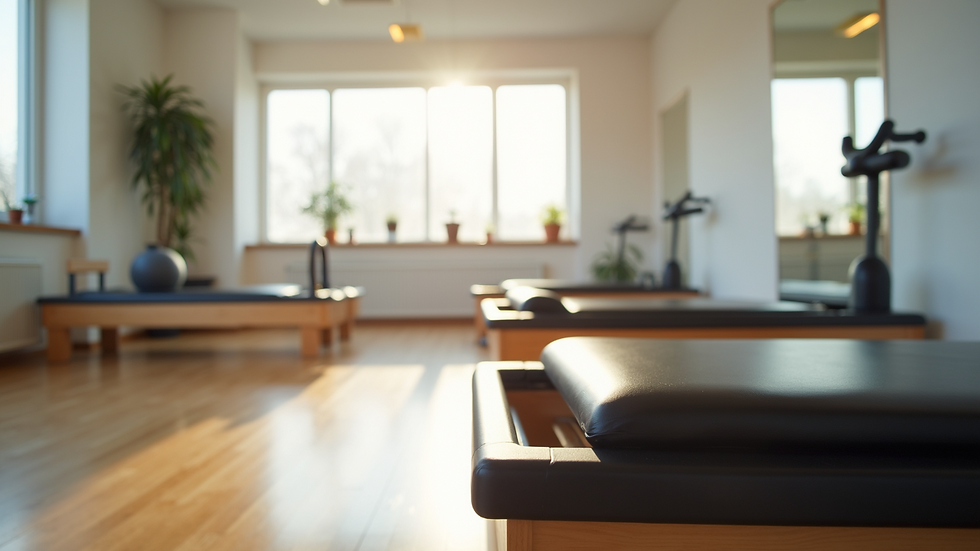Discover How Pilates Enhances Recovery
- andrebanks19729
- Oct 20
- 4 min read
Pilates is more than just a fitness trend - it is a powerful tool for enhancing recovery and improving overall well-being. Whether recovering from an injury, surgery, or simply looking to boost your body's natural healing process, Pilates offers a unique approach that combines strength, flexibility, and mindful movement. This article explores the many ways Pilates supports recovery and why it might be the perfect addition to your rehabilitation routine.
Understanding the Benefits of Pilates Classes for Recovery
Pilates focuses on controlled movements that engage the core muscles, improve posture, and increase flexibility. These elements are crucial for recovery because they help restore balance and function to the body without causing strain or injury.
Some key benefits of Pilates classes include:
Improved muscle strength and tone: Pilates targets deep stabilizing muscles that are often neglected in traditional workouts. Strengthening these muscles supports joints and reduces the risk of re-injury.
Enhanced flexibility and mobility: Gentle stretching and lengthening movements increase range of motion, which is essential for regaining normal movement patterns after injury.
Better posture and alignment: Pilates emphasizes proper alignment, which can alleviate pain caused by poor posture and promote efficient movement.
Low-impact exercise: Pilates is gentle on the joints, making it suitable for people recovering from surgery or chronic conditions.
Mind-body connection: The focus on breathing and concentration helps reduce stress and promotes relaxation, which can accelerate healing.
By incorporating Pilates into your recovery plan, you can rebuild strength and mobility safely and effectively.

Pilates equipment designed to support controlled and safe movements during recovery
How Pilates Classes Improve Physical Rehabilitation
Physical rehabilitation often requires a balance between rest and movement. Pilates provides a structured way to reintroduce movement without overloading the body. Here’s how Pilates supports physical rehab:
Targeted muscle activation: Pilates exercises isolate specific muscle groups, allowing you to strengthen weak areas without compensating with other muscles.
Controlled movement patterns: The slow, deliberate motions help retrain the nervous system and improve coordination.
Core stabilization: A strong core supports the spine and pelvis, which is vital for recovering from back injuries or surgeries.
Joint protection: Pilates movements are designed to protect joints by promoting proper alignment and avoiding excessive strain.
Progressive difficulty: Exercises can be modified to match your current ability and gradually increase in intensity as you heal.
For example, after knee surgery, Pilates can help strengthen the muscles around the knee while improving flexibility and reducing swelling. This targeted approach speeds up recovery and reduces the risk of future injury.

Personalized Pilates instruction ensures safe and effective rehabilitation
The Role of Pilates in Mental and Emotional Recovery
Recovery is not just physical - it also involves mental and emotional healing. Pilates incorporates mindful breathing and concentration, which can have profound effects on mental well-being.
Stress reduction: Focused breathing techniques calm the nervous system and reduce cortisol levels, helping to manage pain and anxiety.
Improved sleep: Regular Pilates practice can improve sleep quality, which is essential for tissue repair and overall recovery.
Enhanced body awareness: Pilates encourages tuning into your body’s signals, helping you avoid movements that cause pain or discomfort.
Boosted confidence: As strength and mobility improve, so does self-esteem, which can motivate continued progress.
These mental benefits complement physical healing and create a holistic recovery experience.
Practical Tips for Incorporating Pilates into Your Recovery Routine
If you’re considering Pilates to aid your recovery, here are some actionable recommendations:
Consult your healthcare provider: Before starting Pilates, get approval from your doctor or physical therapist to ensure it’s safe for your condition.
Find a qualified instructor: Look for instructors experienced in rehabilitation and familiar with modifying exercises for injuries.
Start slow and listen to your body: Begin with beginner-level classes or private sessions to learn proper form and avoid overexertion.
Use supportive equipment: Props like resistance bands, Pilates rings, and reformers can assist with gentle strengthening and flexibility.
Be consistent: Regular practice, even just 2-3 times per week, can yield significant improvements over time.
Combine with other therapies: Pilates works well alongside physical therapy, massage, and other recovery modalities.
For those in the Chicago area, joining pilates classes in chicago can provide access to expert guidance and a supportive community focused on recovery.

Pilates equipment helps customize exercises for individual recovery needs
Embracing Pilates for Long-Term Health and Wellness
Beyond immediate recovery, Pilates offers lasting benefits that support long-term health. Regular practice can:
Prevent future injuries by maintaining muscle balance and joint stability.
Improve posture and reduce chronic pain related to poor alignment.
Enhance athletic performance by increasing core strength and flexibility.
Promote a healthy lifestyle through mindful movement and stress management.
By making Pilates a part of your routine, you invest in your body’s resilience and overall quality of life.
Recovery is a journey that requires patience and care. Pilates provides a gentle yet effective path to healing, helping you regain strength, mobility, and confidence. Whether recovering from an injury or simply seeking to improve your physical and mental well-being, Pilates offers a comprehensive approach that supports your body every step of the way.



Comments